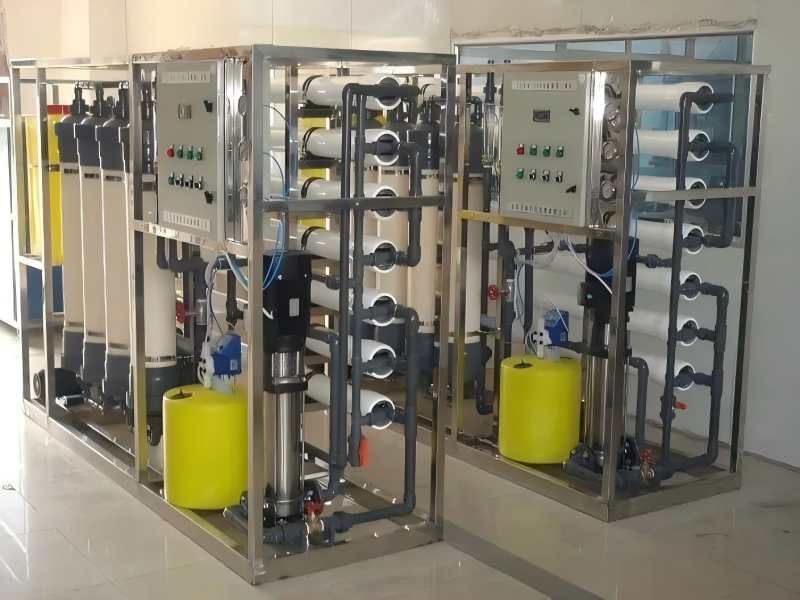Marketing Hotline:
(+86)0532-88988868
(+86)0532-88988868
Pure water refers to pure water, which is generally filtered through multiple layers of urban tap water, which can remove harmful substances such as microorganisms, but also remove minerals needed by the human body such as fluorine, potassium, calcium, and magnesium.

(1)Ozone sterilization ultrapure water treatment
The disinfection principle of process ozone (O3) is: ozone has an unstable molecular structure at room temperature and pressure, and quickly decomposes into oxygen (O2) and a single oxygen atom (O) by itself; The latter has strong activity, has a strong oxidation effect on bacteria, kills it, and the excess oxygen atoms will recombine themselves into ordinary oxygen atoms (O2), without any toxic residues, so it is called a non-polluting disinfectant, it not only has a strong killing ability against various bacteria (including hepatitis virus, Escherichia coli, Bacillus aeruginosa and miscellaneous bacteria, etc.), but also is very effective in killing mycin.
1. The sterilization mechanism and process of ozone belong to the biochemical process, which oxidizes and decomposes the glucose oxidase, which is necessary for the oxidation of glucose in bacteria.
(2) It directly interacts with bacteria and viruses, destroys its organelles and ribonucleic acid, decomposes DNA, RNA, proteins, lipids and polysaccharides and other macromolecular polymers, and destroys the material metabolism, production and reproduction process of bacteria.
(3) Penetrate the cell membrane tissue, invade the cell membrane and act on the lipoproteins in the outer membrane and the lipopolysaccharide inside, causing the cell to undergo permeabilization and distortion, resulting in cell lysis and death. In addition, the genes, parasitic strains, parasitic virions, bacteriophages, mycoplasma and heat sources (bacterial and viral metabolites, endotoxins) in the dead bacteria are dissolved, denatured, and destroyed.
3. Membrane microporous filtration treatment process
There are three types of membrane microfiltration (MF) filtration: depth filtration, screen filtration, and surface filtration.
Depth filtration is a matrix made of woven fibers or compressed materials, which uses adsorption or capture methods to retain particles, such as commonly used multi-media filtration or sand filtration; Depth filtration is a cost-effective way to remove more than 98% of suspended solids while protecting downstream purification units from clogging, so it is often used as a pretreatment.
Surface filtration is a multi-layer structure, when the solution passes through the filter membrane, particles with larger pores than the inside of the filter membrane will be left behind, and mainly accumulate on the surface of the filter membrane, such as the commonly used PP fiber filtration. Surface filtration removes more than 99.9% of suspended solids and can also be used as a pretreatment or clarification.
The screen membrane is basically a consistent structure, just like a sieve, leaving particles larger than the pore size on the surface (the pore measurement of this filter membrane is very accurate), such as the security filter used in the terminal of the ultrapure water machine; Mesh filtrationMicroporous filtration is typically placed at the point of final use in the purification system to remove the last residual trace resin flakes, carbon shavings, colloids, and microorganisms.
5. Reverse osmosis (RO) pure water treatment process
It is a substance separation process that uses the selectivity of reverse osmosis membrane to extract pure water from water containing various inorganic, organic and microbial substances by using the selectivity of reverse osmosis membrane that can only permeate water and cannot penetrate solutes. The pore size of the reverse osmosis membrane is less than 10 angstroms (1 angstroms is equal to 10-10 meters), and it has a strong screening effect, with a desalination rate of up to 99% and a sterilization rate of more than 99.5%. It can remove impurities such as inorganic salts, sugars, amino acids, bacteria, and viruses in water. RO is the most economical and effective method for purifying tap water and the best pretreatment method for ultrapure water systems when properly designed based on raw water quality and produced water quality.
6. Ultrafiltration (UF) pure water treatment process
Microporous membranes remove particulates according to their filter pore size, while ultrafiltration (UF) membranes are like a molecular sieve, which uses size as a benchmark to pass the solution through very fine pores to achieve the purpose of separating molecules of different sizes in the solution.
Ultrafiltration membranes are strong, thin, and selectively permeable membranes that are generally considered to have a pore size of about 0.01 μm, which can retain molecules above a certain size, including: colloids, microorganisms, and heat sources. Smaller molecules, such as water and ions, can pass through the membrane.
7. Ultraviolet and ozone sterilization treatment process
The 254nm/185nm ultraviolet light emitted by the UV lamp can effectively kill bacteria and degrade organic matter.
8. EDI pure water treatment process
A new method of deionized water treatment. Also known as continuous electrodesalination, an EDI unit combines an ion exchange resin between an anion/cation exchange membrane to form an EDI unit. This method does not need to regenerate the resin with acid and alkali, and is environmentally friendly.


